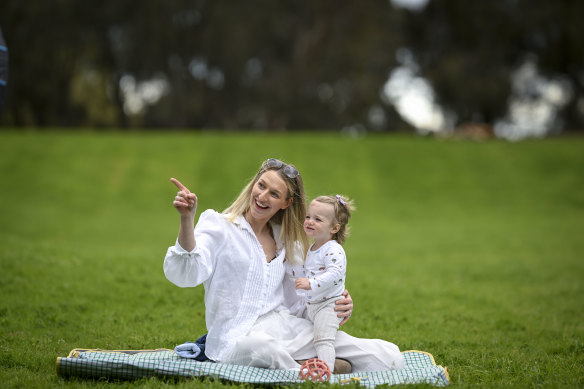- Exclusive
- National
- Victoria
- Healthcare
This was published 10 months ago
Older, heavier and empowered: Record number of mums are having caesareans
A record 41 per cent of babies born in Victoria are now delivered via caesarean, with obstetricians attributing the trend to older, heavier mothers and a fear of birth trauma.
The proportion of women having vaginal births at Victorian public and private hospitals has dropped from around 85 per cent in 1985 to an all-time low of 59 per cent in 2022, according to a Safer Care Victoria report published this week.

Anna Burger and her daughter Chessie, 15 months old, who was born via caesarean. Credit: Eddie Jim
Unassisted vaginal births, which do not involve instruments such as forceps or vacuum cups, sit even lower at 45 per cent of all births.
The Australian College of Midwives is worried about the health impacts of caesareans on mothers and babies and has warned they will soon overtake vaginal births unless government, hospitals and health professionals take action.
“It’s a concern,” said the organisation’s chief midwife Alison Weatherstone.
Weatherstone said women who had a caesarean birth took longer to recover, were less likely to successfully breastfeed and faced an increased likelihood of complications for future pregnancies.
“Some women require life-saving caesarean section, either for themselves or their babies,” she said. “Birth is a normal physiological event, and women should be encouraged to approach this without fear.”
She said women needed to be given more support to have a vaginal birth, which might include having continuity of care with a midwife.
“The minute you have a caesarean section, then you are more likely to have a repeat caesarean section, and then that becomes a social norm.”
Dr Nisha Khot, vice president of the Royal Australian and New Zealand College of Obstetricians and Gynaecologists, said the increasing age and BMI (body mass index) of mothers was fuelling the upward tick in caesarean births.
“As we get older we may have other associated health issues such as diabetes and blood pressure issues which plays into decisions about birth,” Khot said.
In Victoria, the median age of a woman giving birth for the first time was 31 in 2022, compared with 29 in 2014. The Safer Care Victoria report said 52 per cent of pregnant women were overweight or obese in 2022.
Khot, who also works as an obstetrician at public hospital service Peninsula Health, said some women were electing a caesarean following a traumatic vaginal birth.
“They want a caesarean as a way of managing the trauma,” she said. “That may be a sensible way to manage their own mental health and wellbeing. It is important to support women to make that decision.”
There is growing awareness about the impact of birth trauma in Australia, with one study finding that more than one in 10 women were made to feel violated, powerless or dehumanised while giving birth.
Dr Kara Thompson, a private obstetrician who works in Geelong, said a small but growing number of women were choosing caesareans for non-medical reasons.
“Women are empowering themselves with their own education and information about potential birth outcomes and complications, and increasingly, they are not willing to accept the potential risk of vaginal birth,” she said.
Thompson warned that a focus on reducing national caesarean rates could harm women.
“Where we have tried to bring down caesarean rates we have increased forceps rates, stillbirths and perinatal mortality,” she said.
“You risk valuing ideology over individual women’s preferences and safety.”
Anna Burger, 31, chose a caesarean for the birth of daughter Chessie after she was advised that she was small for her gestational age at the 30-week check-up.
The emergency doctor from Geelong delivered Chessie at 37 weeks and describes the experience as “the most easy, stress-free process”.
“I got up in the morning, did pilates, went for a walk and then drove to the hospital,” she recalled. “She was a click-and-collect baby.”
Burger said she had been on the fence about having a vaginal birth because she had witnessed the complications that could occur while working in a hospital.
“At the same time I had a lot of friends who had a vaginal delivery and it had been beautiful.”
She said while she knew the first 48 to 72 hours following the caesarean would be tough, her recovery was a dream.
“After the 72-hour mark I was up and walking. The scar has healed well. I have no concerns about it.”
A Safer Care Victoria spokesperson said the increase in caesarean births in Victoria was consistent with national and global trends.
“Decisions leading to a caesarean section birth, both elective and emergency, are complex and are made collaboratively with the woman to ensure the safety of her and her baby,” they said.
Start the day with a summary of the day’s most important and interesting stories, analysis and insights. Sign up for our Morning Edition newsletter.